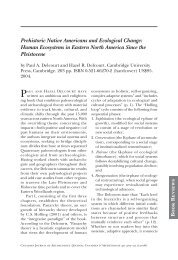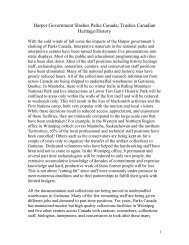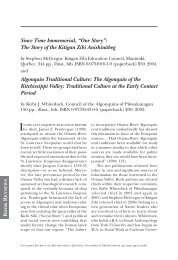(1): numéro de l'atelier / session number Abel, Tim - Canadian ...
(1): numéro de l'atelier / session number Abel, Tim - Canadian ...
(1): numéro de l'atelier / session number Abel, Tim - Canadian ...
- No tags were found...
You also want an ePaper? Increase the reach of your titles
YUMPU automatically turns print PDFs into web optimized ePapers that Google loves.
a preferential organization, both in space and in seasonal cycle, of technical activities.Moreover, spatial analysis of those data allows us to study household dynamics andgen<strong>de</strong>r interactions. Que s’est-il passé à cet endroit ? Percevoir les stratégies économiqueset les relations sociales au-<strong>de</strong>là <strong>de</strong>s données tracéologiques. - La détermination <strong>de</strong> lafonction <strong>de</strong>s outils, par l’analyse tracéologique, ne constitue pas une fin en soi.L’interprétation <strong>de</strong>s données fonctionnelles doit impérativement permettre d’abor<strong>de</strong>r ladimension <strong>de</strong>s choix techniques et culturels et, dans une perspective plus large, lesstratégies socioéconomiques <strong>de</strong>s peuples <strong>de</strong> chasseurs-cueilleurs étudiés. Or, le recours àl’ethnoarchéologie et à certains concepts anthropologiques est nécessaire à l’atteinte <strong>de</strong>cet objectif. Il sera démontré que grâce à l’obtention <strong>de</strong> sous-catégories fonctionnelles(analyse <strong>de</strong>s traces d’utilisation à fort grossissement) à partir <strong>de</strong> catégories typologiquesclassiques, il est possible d’observer une organisation préférentielle, tant dans l’espacequ’au cours du cycle saisonnier d’exploitation <strong>de</strong>s ressources, <strong>de</strong>s activités techniques. Deplus, l’analyse du mo<strong>de</strong> <strong>de</strong> répartition spatiale <strong>de</strong> ces données permet l’étu<strong>de</strong> <strong>de</strong> lamicroéconomie domestique ainsi que <strong>de</strong>s relations entre les genres.Dorland, Steven (University of Toronto) The Insi<strong>de</strong> is What Counts: an analysis ofregional i<strong>de</strong>ntity associated with interior and exterior pottery <strong>de</strong>coration (4) Recently,there has been a shift to recognize regional variation associated with pre-contact southernOntario, <strong>de</strong>monstrable through environmental, social and i<strong>de</strong>ational contexts. This paperfocusses on regional strategies associated with Late Woodland pottery <strong>de</strong>coration. Twosite assemblages dating roughly to the 13 th and 14 th century A.D. respectively, wereanalyzed during this study; the Holly site in Simcoe County, and the Antrex site in themunicipality of Peel. My analysis led me to i<strong>de</strong>ntify stylistic relations present amongvariables located on varying sections of the vessel. By applying a multi-attribute analysis,my research <strong>de</strong>monstrated the Antrex site has the same <strong>de</strong>coration on the interior and necksections of the vessel, roughly three times more than what was apparent among the Hollyassemblage. The results indicate possible regional variation relating to alternate strategiesfor actively displaying group i<strong>de</strong>ntity, at a time when consi<strong>de</strong>rable social change wasoccurring in the area.Downey, Jordan and Jean-François Millaire (The University of Western Ontario)Satellite Imagery and the Development of the Virú State on the North Coast of Peru (1)Satellite remote sensing has become a standard aspect of archaeological inquiry in the last<strong>de</strong>ca<strong>de</strong> thanks to the wi<strong>de</strong>spread availability of low-cost satellite data and powerfulanalytical computer software. A particular strength of digital satellite imagery is its readyintegration into GIS platforms, which has been ma<strong>de</strong> all the more seamless with the recentarrival of ArcGIS 10. Through this and other platforms, high-resolution satellite imageryis available for the coast of Peru yet few studies have ma<strong>de</strong> use of its potential forstudying the socio-political organization of ancient An<strong>de</strong>an societies. In this paper, we usesatellite imagery to explore the <strong>de</strong>velopment of centralized polities in the Virú Valleyduring the first half of the Early Intermediate Period, a time that witnessed extensiveremo<strong>de</strong>lling of the landscape in conjunction with the <strong>de</strong>velopment of the Virú statearound 150 B.C.Doyon, Luc (Université <strong>de</strong> Montréal) Droulers 3.0 – Les SIG et le patrimoine du Haut-Laurent (5) Les systèmes d'information géographique constituent <strong>de</strong>s outils permettant la








